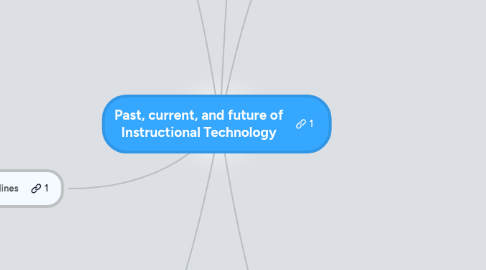
1. Influential people
1.1. Piaget
1.1.1. Developmental theory
1.2. McLuhan
1.2.1. Media is Message
1.3. Skinner
1.3.1. Father of Behaviorism
1.4. Vigotsky
1.4.1. Social constructivism
1.5. Jonassen
1.5.1. PBL
1.6. Dewey
1.6.1. Learning by Doing
1.7. Keller
1.7.1. ARCS / Motivation
1.8. Merril
1.8.1. Component Display Theory
1.9. Hanaffin
1.9.1. Scaffolding
2. Social and histrorical context/changes
2.1. 1920s The Audiovisual Instruction Movement and Instructional Radio
2.2. 1908 Visual Instructional Movement and Instructional Films
2.3. World War II
2.3.1. School needs slowed
2.3.2. Military Training
2.4. Communication Theory
2.4.1. Models Established
2.5. Instructional TV
2.5.1. 1952, 242 Educational Channels
2.5.2. Ford Funding
2.6. Using computers as Instructional Tools
2.6.1. 1950s, IBM
2.6.2. 1980s, Public School
2.6.3. 1990s, Few contributions
2.7. Recent Developments
2.7.1. Technology Development
2.7.2. Business and Industry
2.7.3. School Education
2.7.4. Military
3. Related diciplines
3.1. Communication
3.2. Psychology of learning
3.2.1. Behaviorism
3.2.2. Cognitivism
3.2.3. Constructivism
3.3. Computer Science & Engineering
3.3.1. Human Computer Interaction
3.3.2. Data Anaysis
3.4. Evaluation
3.4.1. Formative Evaluation
3.5. Media
3.5.1. McLuhan
3.6. Philoshophy
4. Definition
4.1. Interdisciplinary field that studies how to enhance teaching, learning, and performance, and facilitate the development and delivery of instruction.
4.1.1. Ethical practice
4.1.2. Educational settings or in the workplace.
4.1.3. Diverse resources and emerging technologies.
4.1.4. Iterative processes of ISD or non-instructional solutions.
5. Theoretical Changes
5.1. Behaviorism
5.1.1. Learning is a direct result of a specific environmental stimulus that is conducive to a change in behavior. Behaviors can be modified and the mind is viewed as a “black box”
5.1.1.1. Main contributors to behaviorism: Pavlov, Watson, Thorndike, and Skinner
5.1.1.2. The teacher finds the cues that elicit the desired responses and arranges practice situations for the learners.
5.1.1.3. The learner reacts to a stimulus and does not take an active role in discovering his/her environment.
5.1.1.4. Applications of behaviorism are behavioral objectives, task analysis, criterion-referenced assessment, informative feedback and sequencing of instructional presentation.
5.2. Cognitivism
5.2.1. Cognitivism focuses on the internal mental processes of the learner and views observable behaviors only as indicators of specific cognitive processes. Cognitive theories describe how the mind receives, organizes, stores, and retrieves information.
5.2.1.1. Main contributors: Tolman, Piaget, Vygotsky, Bruner, and Gestalt
5.2.1.2. The teacher provides a rich classroom environment for the student to explore and become an active learner
5.2.1.3. Learners are active member and they're expected to link new concepts with prior knowledge
5.2.1.4. Cognitivism is effective to teach problem solving skills where specific facts and rules are applied in unfamiliar contexts.
5.3. Constructivism
5.3.1. Constructivism is a learning paradigm that explains how knowledge is integrated to existing, experiential knowledge
5.3.1.1. Main contributors: Vygotsky, Piaget, David Ausubel and Jerome Bruner
5.3.1.2. Teachers are supposed to provide students with authentic, realistic and contextualized input, encourage collaboration, interaction and engagement.
5.3.1.3. Students actively engage in tasks, interact and collaborate with other students and teacher
6. Technological changes and its impacts on human life
6.1. Energy and transportation
6.2. Simple machine (lever, screw, pulley, etc,.)
6.3. Industrial Revolution
6.3.1. Steam power
6.3.2. Electricity
6.3.3. Communication tools (telegraph, telephone, radio, TV, and automoblie)
6.4. Information technology
6.4.1. Computer and the Internet
6.4.2. VR and AR
